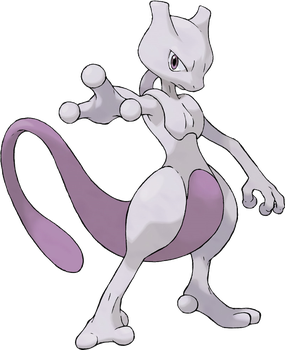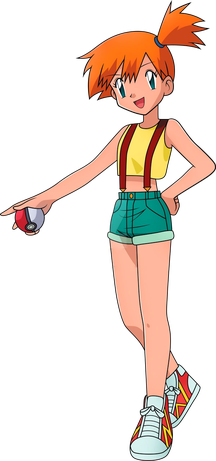
Mewtwo is a Pokémon species in Nintendo and Game Freak's Pokémon media franchise. It was first introduced in the video games Pokémon Red and Blue, and later appeared in subsequent sequels and spin-off titles, such as Pokkén Tournament and Detective Pikachu. In the video games, the player can fight and capture Mewtwo in order to subsequently pit it against other Pokémon. The player can first learn of Mewtwo late in Pokémon Red and Blue by reading research documents left in a ruined laboratory on Cinnabar Island where Mewtwo has escaped. Mewtwo is regarded as one of the series' strongest Pokémon, often referred to as "the world's strongest Pokémon" in various media, and was the strongest in the original games in terms of base statistic distribution. It is known as the "Genetic Pokémon" and is a Legendary Pokémon, a special group of Pokémon that are very rare and usually very powerful. Mewtwo has also appeared in various animated adaptations of the franchise.

Squirtle, known as Zenigame in Japan, is a Pokémon species in Nintendo and Game Freak's Pokémon franchise. It was designed by Atsuko Nishida. Its name was changed from Zenigame to Squirtle during the English localization of the series in order to give it a "clever and descriptive name." In animated appearances, Squirtle is voiced in Japanese by Rikako Aikawa and in English localizations by Eric Stuart, and later Michele Knotz.

Pikachu is a Pokémon species in Nintendo and Game Freak's Pokémon media franchise, and the franchise's mascot. First introduced in the video games Pokémon Red and Blue, it was created by Atsuko Nishida at the request of lead designer Ken Sugimori, with the design finalized by Sugimori. Since Pikachu's debut, it has appeared in multiple games including Pokémon Go and the Pokémon Trading Card Game, as well as various merchandise. While Pikachu has been primarily voiced in media by Ikue Ōtani, other actors have also voiced the character including Kate Bristol, Ryan Reynolds, Kaiji Tang, Hidetoshi Nishijima, Tōru Ōkawa, and Koichi Yamadera.

Eevee is a Pokémon species in the Pokémon franchise. Created by Satoshi Tajiri and designed by Motofumi Fujiwara, it first appeared in the video games Pokémon Red and Blue. It has later appeared in various merchandise, spinoff titles, as well as animated and printed adaptations of the franchise. It is also the game mascot and starter Pokémon for Pokémon: Let's Go, Eevee!

Misty, known as Kasumi in Japan, is a fictional character in the Pokémon franchise owned by Nintendo and created by Satoshi Tajiri. She has appeared as a Gym Leader in the Pokémon video games Pokémon Red and Blue, Pokémon Gold and Silver, and their respective remakes. She was a protagonist in the ongoing anime for the first five seasons, travelling alongside Ash Ketchum and Brock / Tracey to become the world's best Water-type Pokémon trainer before departing home to Cerulean City to run the family gym, but made recurring appearances after and eventually resuming her journey after Ash won the rank of World Champion. The character has also appeared in manga like Pokémon Adventures. She specialises in Water Type Pokémon. Her Japanese voice actress is Mayumi Iizuka, while her English voice was supplied by Rachael Lillis and Michele Knotz.

Mew is one of the many fictional species in the Pokémon franchise. It is a small, pink, Psychic-type Mythical Pokémon, which are incredibly rare and powerful Pokémon typically available only via special events. It was added to Pokémon Red and Blue by Game Freak programmer Shigeki Morimoto at the tail end of the games' development. Though it was not planned to be obtainable, after it was discovered through data mining, its presence in the games was surrounded by many rumors and myths. For years, Mew could not be obtained legitimately in the games except through some specific Pokémon distribution events, though it could be obtained through a variety of glitches.

Psyduck, known as Koduck in Japan, is a Pokémon species in Nintendo and Game Freak's Pokémon franchise. Created by Ken Sugimori, Psyduck first appeared in the video games Pokémon Red and Blue and later in sequels. It has later appeared in various merchandise, spinoff titles and animated and printed adaptations of the franchise. A Psyduck also appears as part of the main cast in the live-action animated film Pokémon Detective Pikachu. Psyduck has been voiced by Michael Haigney and Rikako Aikawa since its debut.

Lucario is a Pokémon species in Nintendo and Game Freak's Pokémon franchise. Created by Game Freak and finalized by Ken Sugimori, Lucario first appeared as a central character in the film Pokémon: Lucario and the Mystery of Mew, then as a cameo in Pokémon Mystery Dungeon: Blue Rescue Team and Red Rescue Team, and later appeared in the video games Pokémon Diamond and Pearl and later sequels. It additionally appears in various, spin-off titles and animated and printed adaptations of the franchise, and has been featured in several forms of merchandise, including figurines, plush toys, and the Pokémon Trading Card Game. Lucario is voiced by Daisuke Namikawa, Daisuke Sakaguchi, Rikako Aikawa and Kiyotaka Furushima in Japanese, and Bill Rogers and Sean Schemmel in English.

Pokémon is a Japanese series of video games developed by Game Freak and published by Nintendo and The Pokémon Company under the Pokémon franchise. It was created by Satoshi Tajiri with assistance from Ken Sugimori. The first games, Pocket Monsters Red and Green, were released in 1996 in Japan for the Game Boy, later released outside of Japan as Pokémon Red Version and Blue Version. The main series of role-playing video games (RPGs), referred as the "core series" by their developers, has continued on each generation of Nintendo's handhelds. The most recently released core series games, Pokémon Scarlet and Violet, were released on November 18, 2022, for the Nintendo Switch.

Pokémon: The First Movie - Mewtwo Strikes Back is a 1998 Japanese anime fantasy adventure film directed by Kunihiko Yuyama. The first theatrical release in the Pokémon franchise, the plot takes place during the first season of Pokémon: Indigo League. The film was first released in Japan on July 18, 1998, to positive reviews, with praise directed at the film's emotional impact and exploration of ethical topics such as cloning, genetic modification, and existentialism.

Charizard, known as Lizardon in Japan, is a Pokémon in Nintendo and Game Freak's Pokémon franchise. Created by Atsuko Nishida, Charizard first appeared in the video games Pokémon Red and Blue and subsequent sequels. They have later appeared in various merchandise, spinoff titles and animated and printed adaptations of the franchise. Shin-ichiro Miki voices Charizard in both the Japanese and English-language versions of the anime. An orange, dragon-like Pokémon, Charizard is the evolved form of Charmeleon and the final evolution of Charmander. It also has two "Mega Evolved" forms, Mega Charizard X and Y, that were likely both designed by Tomohiro Kitakaze, the designer of Mega Charizard X. It also has a Gigantamax form in Pokémon Sword and Shield, which changes its appearance and size.

Jynx, known in Japan as Rougela, is a Pokémon species in Nintendo and Game Freak's Pokémon franchise. Jynx first appeared in the video games Pokémon Red and Blue and sequels, later appearing in various merchandise, spinoff titles, or animated and printed adaptations of the franchise. While no English voice actors have been attributed for the character, in Japan they have been voiced by Mayumi Tanaka, Chie Satō, Kujira and Chiyako Shibahara

Bulbasaur, known as Fushigidane in Japan, is a fictional Pokémon species in Nintendo and Game Freak's Pokémon franchise. First introduced in the video games Pokémon Red and Blue, it was created by Atsuko Nishida with the design finalized by Ken Sugimori. Since Bulbasaur's debut, it has appeared in multiple games including Pokémon Go and the Pokémon Trading Card Game, as well as various merchandise. In media related to the franchise, Bulbasaur has been voiced by various voice actors, including Tara Sands and Michele Knotz.

Mr. Mime, known in Japan as Barrierd, is a Pokémon species in Nintendo and Game Freak's Pokémon franchise. Mr. Mime first appeared in the video games Pokémon Red and Blue and subsequent sequels, later appearing in various merchandise, spinoff titles and animated and printed adaptations of the franchise. Mr. Mime is voiced by Yūji Ueda in Japanese. In English, it was voiced by Kayzie Rogers and Michele Knotz.
Unown is a Pokémon species in Nintendo and Game Freak's Pokémon franchise. Created by Ken Sugimori, Unown first appeared in the video games Pokémon Gold and Silver and most of its subsequent sequels. It has also appeared in various merchandise, spin-off titles, and animated and printed adaptations of the franchise. Unown are hieroglyph-like, thin, black ancient Pokémon usually found on walls. There are twenty-eight forms of Unown: one for each of the twenty-six letters in the Latin alphabet, a question mark, and an exclamation mark. Unown is a Psychic-type Pokémon, and is not able to evolve.

Pokémon the Series: XY is the seventeenth season of the Pokémon animated series and the first and titular season of Pokémon the Series: XY, known in Japan as Pocket Monsters: XY. It is the first dubbed season to use the "Pokémon the Series" branding and as such can be a starting point. The season follows the continuing adventures of Ash Ketchum and Pikachu as they explore the Kalos region. Traveling in the Kalos region with their new friends – Clemont and his little sister Bonnie, along with Ash's childhood friend Serena – the party discover new Pokémon and the mysterious Mega Evolutions.

Mimikyu is a Pokémon species in Nintendo and Game Freak's Pokémon franchise. Designed by Megumi Mizutani for the 2016 video games Pokémon Sun and Moon, it is referred to as the "disguise Pokémon" in the series due to its appearance, which resembles a ragdoll form of Pikachu, the series mascot. Since Mimikyu's debut, it has appeared in multiple games including Pokémon Go and the Pokémon Trading Card Game, as well as the anime adaptation of the series where it is voiced by Billy Bob Thompson.


















